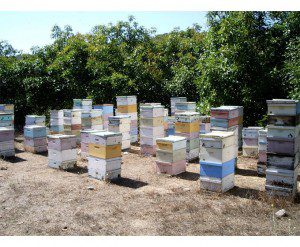

“I can only give you my opinion about what is happening with the bees today. There is a lot of confusion and misinformation, much of which has been caused by all the media attention over the last several years. As I’m sure you know, the press always seems to get things wrong, and emphasizes the doom and gloom “crisis” aspects.
“The fact is that there are many more problems that the bees have to contend with. Globalization has brought a steady stream of pests and diseases which have accumulated and there are no prospects of them going away. Over the past 40 years that I have been keeping bees, I’ve had to deal with this list of new problems:
- Varroa mites – which vector virus
- Tracheal mites – which clog the breathing tubes
- Several virus’ – probably more than we know about
- Nosema ceranae, a microsporidian – lives in the gut and cuts lifespan
- African bees – which caused me to depend on artificial insemination
- Small hive beetle – which eats bee eggs and ferments honey
- Increased pesticide use, and new compounds – especially neoniconitoids which are replacing banned organophosphates, but badly affects bees nervous systems.
“It has become more difficult and expensive to keep bees today. In the old days the bee population was hard to keep down, but now it is difficult to maintain the population in an apiary. Consequently, many beekeepers have given up, hence the number of managed hives has decreased from around 5 million in 1950 to just over 2 million today. The number of beekeepers has decreased. Also the number of feral colonies has gone down since to the introduction of the varroa and trachael mites in the 1990’s.
“However, I don’t believe that honeybees are in any danger of going extinct. The problems are as much to do with economics as with biology. A crisis was declared a couple years ago when the supply of bees was not able to meet the pollination needs of the increasing acreage in almonds orchards in Calif. Pollination fees soared, market forces kicked in, and today there is a glut of bees available for almond pollination.
“The bee industry has benefited from all the attention. Money has become available for research, and the public has a new found appreciation for the value of bees. Frankly, the decline of the bee industry has been slowly happening for decades, the attention today is just catching up with the problem, but is a bit overblown.
“Thank you for asking my opinion. We do have real problems, but rest assured we are not all going to die, as reported in one British tabloid.”
I know Tom because he is a fan of the podcast This Week in Virology:
“I am a honeybee breeder in California, and I listen to Twiv while I’m artificially inseminating queen bees. My work is primarily breeding bees that are resistant to the Varroa mite which as well as sucking the haemolymph (blood) of the bees, also is a vector for virus. One of the virus involved in the demise of bees is Israeli Acute Paralysis Virus (IAPV) which was discovered by your colleague Ian Lipkin. So I discovered Twiv in an effort to learn more about virus. Just about evertyhing I know about virus comes from listening to your show. With an eighty hour work week during bee season, I really appreciate being able to get good educational information while my hands are otherwise engaged.”
I thank Tom for his thoughtful reply and his interest in learning more about viruses. If you want to learn more about beekeeping, visit his website or blog.

Pingback: Tweets that mention Are the bees vanishing? -- Topsy.com
Pingback: uberVU - social comments
Another problem, still hypothetical and yet to be demonstrated with evidence, is that air pollution is destroying the molecules bees use to navigate to their flowers. When once the fragrance of flowers spread far and wide, now their range is limited, so bees cannot find their food. Preliminary modelling studies support this, but no one has yet looked for evidence. But it is a possible additional pressure on bee populations. (This suggestion was presented by Dr. Jose Fuentes at a recent meteorology colloquium at Penn State.)
Pingback: [Avian Flu Diary] Weekly Roundup of Flublogia | Influenza Virus Mashup
Has anyone delved into the possibilities of the bee's having Morgellons Disease? It is imperative that it get reported if any do. I don't know how they would find it in the bees. In humans it can be found with a micro-magnifying glass after washing with certain things that bring it out. Like Dawn detergent or Lemon Juice, Coconut oil. The fibers appear black, blue, red and white or as dots on the skin. The CDC has not been forthcoming in the hiring of one lab to identify its species of origin. But the bees must be protected if and when it can be determined.
Has anyone delved into the possibilities of the bee's having Morgellons Disease? It is imperative that it get reported if any do. I don't know how they would find it in the bees. In humans it can be found with a micro-magnifying glass after washing with certain things that bring it out. Like Dawn detergent or Lemon Juice, Coconut oil. The fibers appear black, blue, red and white or as dots on the skin. The CDC has not been forthcoming in the hiring of one lab to identify its species of origin. But the bees must be protected if and when it can be determined.